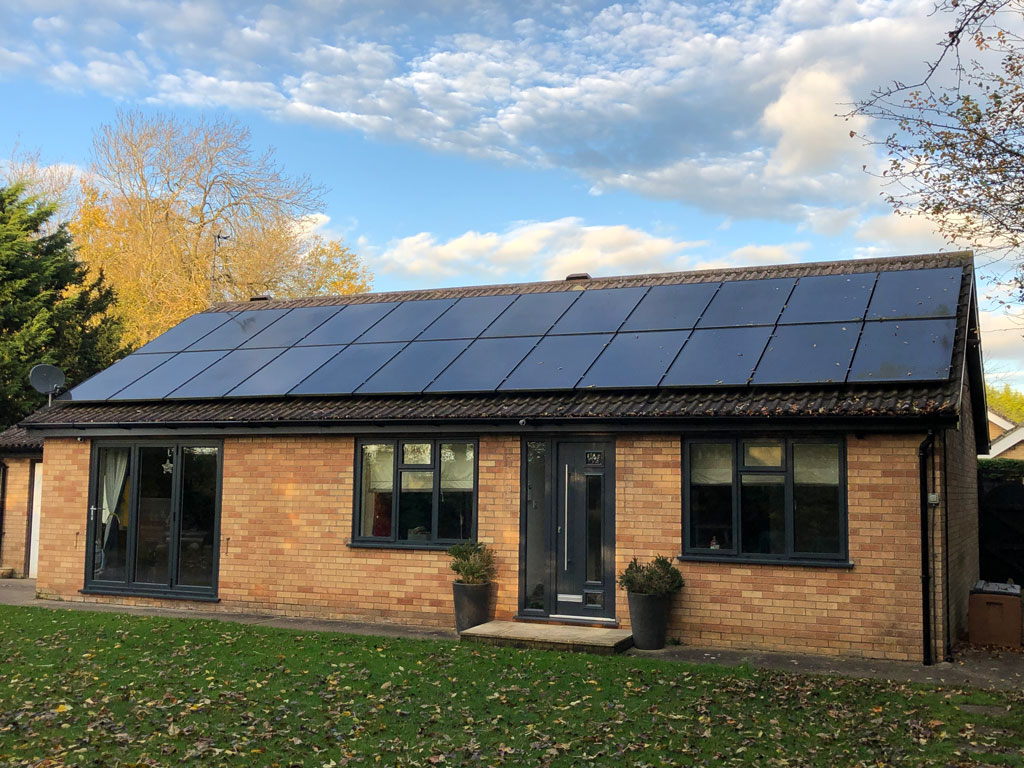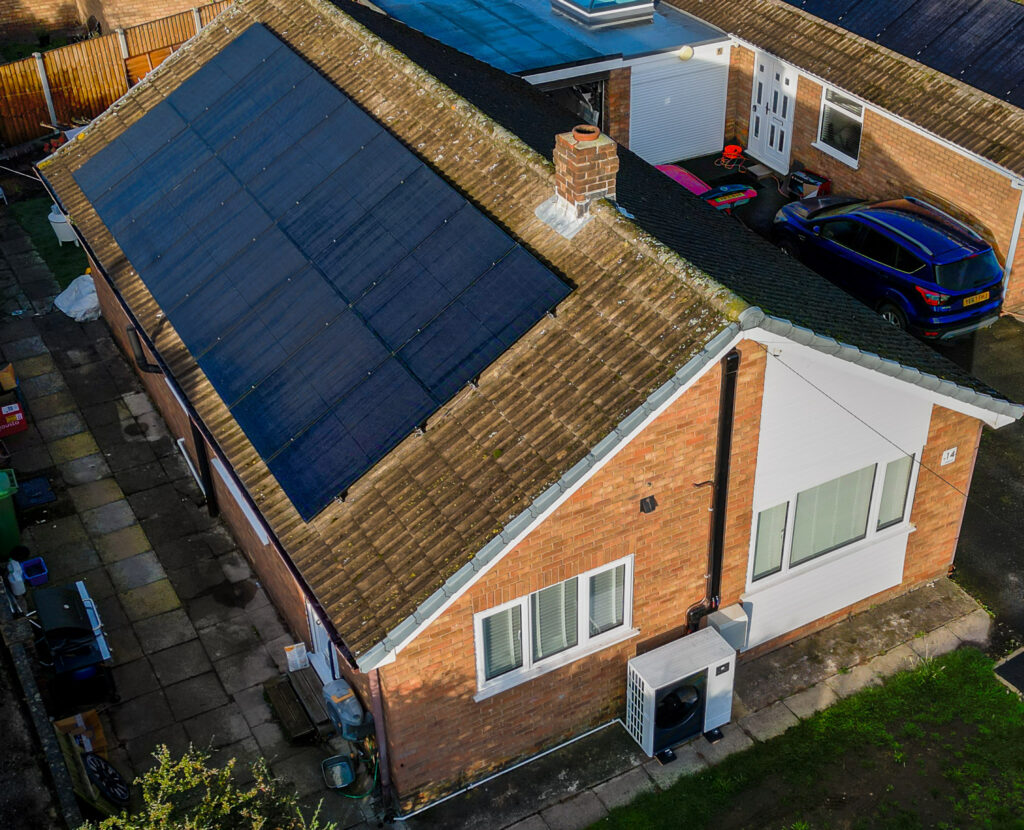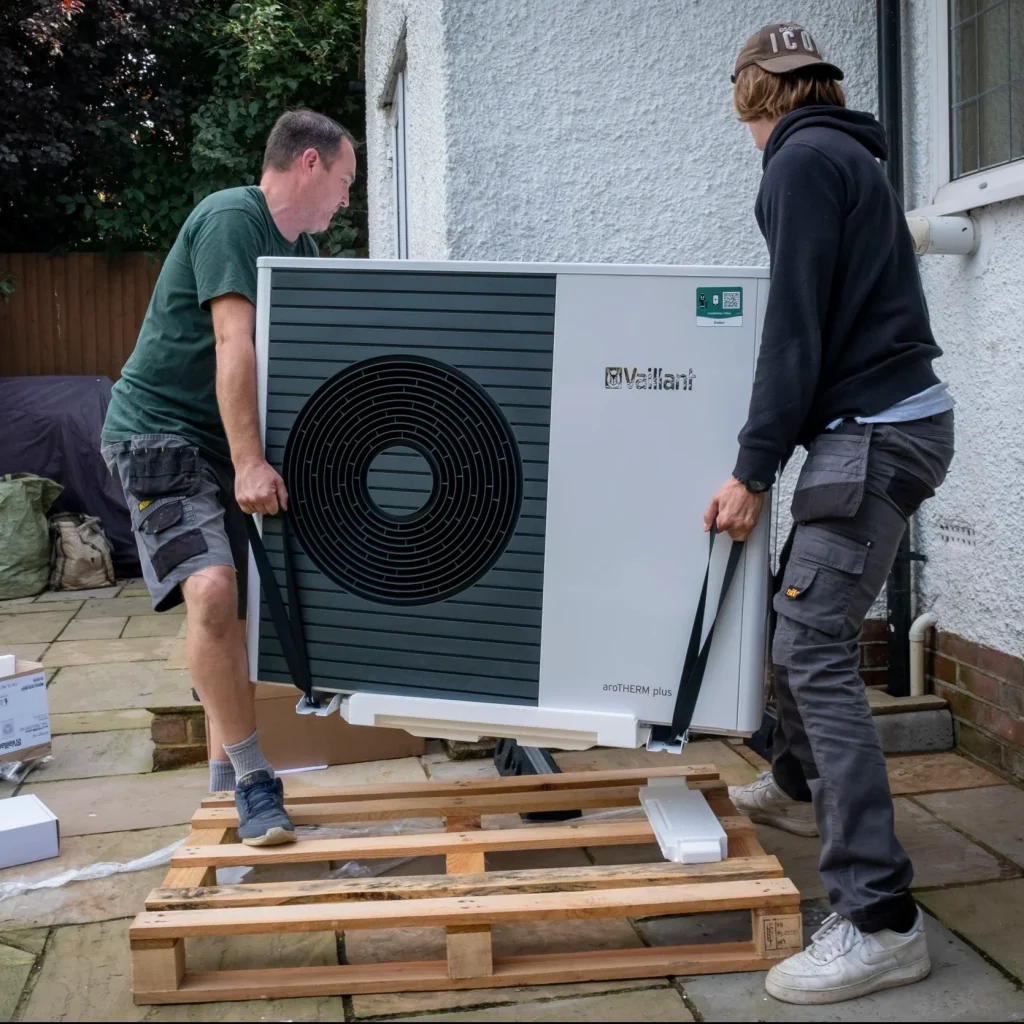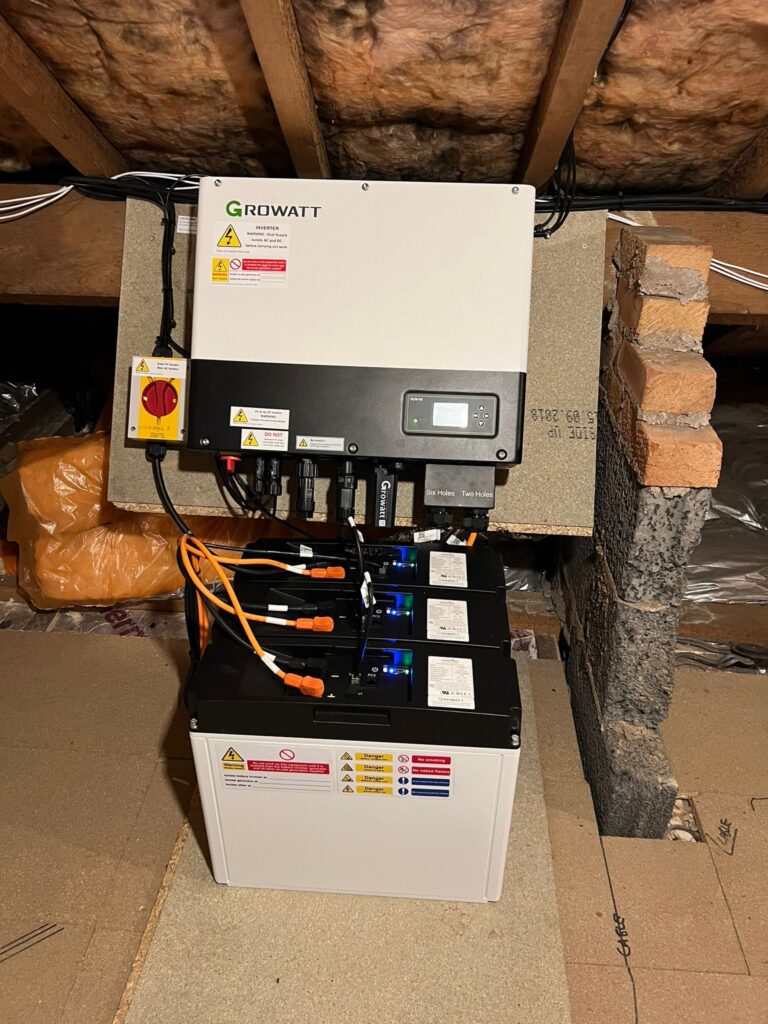Adding to the complexity, I had to consider the lower operating temperatures of these pumps, which turned out to be an unnecessary worry, as this is all built into the MCS calculations that are done before installation. Despite this worry, if sized correctly, I knew an air source heat pump would meet all my domestic heating and hot water needs. It’s not just about the boiler upgrade scheme or the costs involved; it’s about making a responsible, well-informed decision that makes me comfortable with the environmental aspect and long-term financial planning.
Understanding Air Source Heat Pumps and Their Functionality
As an increasingly popular choice for not just for eco-conscious homeowners, but all homeowners, air source heat pumps (ASHPs) are transforming the way we heat our homes. By utilising the ambient air as a renewable heat source, these systems offer a new super efficient alternative to traditional fossil-fuelled heating methods. I have tried to take a deeper look and explain to you how these heat pumps function and what sets them apart in the world of domestic heating solutions.
How Air Source Heat Pumps Work
The core principle behind a heat pump system is its ability to transfer heat from one place to another. Despite common misconceptions, an air source heat pump is capable of extracting heat even when outdoor temperatures are as low as -25 degrees Celsius, which to most people, including myself, seems completely bizarre. This is achieved through a refrigerant fluid that absorbs the heat before a compression cycle releases the heat to be circulated inside a home.
We have a full guide on ‘How Air Source Heat Pumps Work‘ if you would like to know the complete inner workings of a heat pump.
Characteristics of Air to Water Heating Systems
The most popular type of ASHP is the air to water heating system, which is designed to operate with water-based heating elements such as radiators and underfloor heating systems. By harnessing low-grade heat from the outdoor air, then upgrading it to heat water to temperatures averaging at 50 degrees Celsius, they provide a comfortable and sustainable heating solution throughout the home. Different heat pumps will work to a high temperature, they are called, you guessed it ‘high temp heat pumps‘, but higher does not always mean better, as the hotter each system runs, the less efficient it becomes, so 50 degrees is the happy medium, and the standard set by the Microgeneration Certification Scheme (MCS). If your house is 100% underfloor heating, then a lower design temperature will be required in comparison to radiators, usually around 35 degrees.
Heat Pumps Will Require Radiator Upgrades
To ensure the correct functioning of what some people call a heat source pump for short, it may be necessary to upgrade existing radiators for new higher output radiators. Due to the lower operating temperatures of ASHPs, in comparison to gas and oil heat systems, traditional radiators may not have a high enough output to achieve the desired room temperatures. Therefore, larger higher output radiators may need to be installed, the design calculations will specify the output required once your home has been surveyed. The principle of larger radiators is based on having a lower flow temperature in the heating system, the lower the flow temperature, the larger the radiator is needed.
One of the most common things I have heard from discussing heat pumps with friends and colleagues, is that people can be reluctant to change their radiators, saying things such as “I don’t like my house too hot”, however the point of radiator upgrades has been completely misunderstood here. The upgraded radiators are not just to get the house warm, but to do it as fast as possible! The faster the heat can get out of the air source heat pump, and into the radiators, which then let the heat out into your rooms, then the cheaper it will be to run the system!
Insulation and Heat Pump Efficiency
When contemplating the switch to a heat pump system, it’s not just the air source heat pump cost that matters, but also the readiness of the property to support low carbon technology effectively. Insulation stands as the silent yet crucial factor that can steer a heat pump’s performance from good to exceptional. I have tried to set out how insulation influences efficiency and what you need to know prior to installation.
Improving Home Insulation for Better Heat Pump Performance
To get straight to the point, loft and wall insulation is the most important measure you can take to make a house suitable for a heat pump, there is no short cut. Sufficient insulation acts much like a thermal envelope, locking in the warmth and ensuring the output of a heat pump isn’t lost through the walls, floors and ceiling. This is especially pertinent for air source heat pumps, where heat pumps run at a lower temperature based on a continual heating process, heat leakage can significantly diminish overall efficiency and cost-effectiveness.
From an investment point of view, any insulation measures will be a good move when considering installing a heat pump. Draughtproofing around windows and doors can also make a significant difference. A well-insulated home requires less energy to stay warm, allowing an air source heat pump to operate within its ideal parameters, thus financially optimising your return on investment.
Assessing Your Home’s Insulation Before Installation
Before having a heat pump you will need heat loss survey carried out on the property, specialist installers do this, so isn’t something you need to do before inviting companies around to give you a quotation. The audit of insulation levels was done by my installer and it was clear for me to see the workings upon their second visit. I had already recognised the importance of gauging my home’s insulation status prior to looking at an air source heat pump. It’s crucial to identify any potential weak spots where heat could escape, such as through insufficient loft insulation or notorious drafty windows, then getting these issues rectified before a heat pump is fitted.
The main areas of concern in most homes are:
- Loft and Attic Spaces: 200mm or more loft insulation will bring up to modern day specification.
- Walls: Cavity wall insulation or solid internal wall insulation (IWI) is a game-changer in older properties like mine.
- Floors and Basements: These often-overlooked areas are the hardest to rectify, usually because there is little or no access without major disruption.
A heat loss survey helped us figure out the most cost effective insulation upgrades, laying the groundwork for a successful heat pump installation. This experience highlighted the idea that making renewable energy systems efficient isn’t solely reliant on cutting-edge technology; it’s equally about tapping into the basic principles of thermodynamics at home.
The following table illustrates the potential impact of insulation improvements on the efficacy and running costs of my heat pump:
| Insulation Area | Before Improvement | After Improvement | Percentage Efficiency Gain |
|---|
| Loft | Poor | 200mm or loft insulation | Up to 25% |
| Cavity walls | Non-existent | Cavity walls filled | Up to 40% |
| Floors | Minimal | Sealed and insulated | Up to 20% |
| Window glazing | Single | Double/triple glazing | Up to 25% |
It’s clear that for any homeowner in the UK considering the installation of an air source heat pump, overlooking and neglecting property insulation is not the best option. The intimate link between a snugly wrapped home and the consistency of a modern heat pump system is the definition of a match made in heaven.
Assessing the Suitability of Your Property for a Heat Pump System
Following on the the above point, an air source heat pump will almost always get to a good level of heat in your home, as long as it is the right capacity, but the simple equation is as follows:
- Low insulation levels = Larger heat pump, larger radiators, higher installation and running costs.
- Good insulation levels = Smaller heat pump, smaller radiators, lower installation and running costs.
Both of the above will get you you to the same end goal, but having a well insulated house, is a no brainer, for both environmental and financial reasons.
Finding a Location For Your Heat Pump to Sit
Before porceeding I needed to identify a suitable exterior space. A heat pump requires ample airflow to efficiently extract heat; hence, I scoured my property for a spot that was not only on solid ground, but also a distance from potential obstructions such as plants and neighbours fencing. Mounting it to an external wall was also an option I considered, I was told by the installers that the wall brackets have in-built rubber mounts to stop vibrations, however I did have ground space at my house to situate the heat pump and I personally think sitting a heat pump on the ground should always be first choice, using a wall only as a last resort. I even checked planning regulations to ensure that the installation would comply with both the town and country planning act, as well as MCS requirements.
The main planning rules for air source heat pumps include some location based requirements, as well as other regulations around the heat pump size and noise necessities, which are already manufacturer built into the design and engineering of the air source heat pump.
- The volume of the air source heat pump’s outdoor compressor unit (including housing) must not exceed 0.6 cubic metres.
- Only the first installation of an air source heat pump would be permitted development, and only if there is no existing wind turbine on a building or within the curtilage of that property. Additional wind turbines or air source heat pumps at the same property requires an application for planning permission.
- All parts of the air source heat pump must be at least one metre from the property boundary.
- Installations on pitched roofs are not permitted development. If installed on a flat roof all parts of the air source heat pump must be at least one metre from the external edge of that roof.
- Permitted development rights do not apply for installations within the curtilage of a Listed Building or within a site designated as a Scheduled Monument.
- On land within a Conservation Area or World Heritage Site the air source heat pump must not be installed on a wall or roof which fronts a highway or be nearer to any highway which bounds the property than any part of the building.
- On land that is not within a Conservation Area or World Heritage Site, the air source heat pump must not be installed on any part of a wall above the level of the ground floor storey if that wall fronts a highway.
(Source: Planning Portal, 2024)
Where Will The Hot Water Cylinder Go?
Next, I needed to consider the placement of the hot water cylinder required for storing domestic hot water, the air source heat pump is heating the hot water cylinder, so the location was important for pipe run planning. I intended to have it within close proximity to the pump to mitigate heat loss in transfer, the airing cupboard seemed an ideal space, and with my property’s layout, I did have a space in the corner of my utility room that could house the cylinder, which is actually closer to the heat pump than the airing cupboard, however it would be intruding upon the storage space downstairs, so I decided that a slightly higher heat loss, due to increased distance between the units, does seem like trade-off I am willing to accept for the extra space I have saved downstairs.
Installing an Air Source Heat Pump: Size and Model Considerations
When upgrading your home with a heat pump, picking the correct size and model of air source heat pump is essential for both correct functioning and optimal efficiency. This process requires balancing the unique aspects of your property and total peak heat demand, against the offerings in the UK market. In my experience taking on board professional advice from air source heat pump installers near me and my house, there are two main areas to make a choice in that are most important, they are, heat pump size (power), then the manufacturer brand.
Determining the Correct Heat Pump Size for Your Home
On this occasion, size truly matters! A unit too small will be overworked and will become less efficient, usually lasting much less than the suggested life expectancy, while an oversized pump again will consume too much power and cost too much to run, think of it as taking a monster truck to your local supermarket once a week, its just not necessary. Therefore the heat loss calculation, once the survey is done, will give you a good idea of the heat requirements of your home, you can then make an information based decision, specific to you, on choosing the perfect size heat pump.
Comparing Models: The Mitsubishi Ecodan Example
The Mitsubishi Ecodan range stands out as a fitting example of how different models cater to varied heating needs. As I’ve researched the vast number of heat pumps out there, comparing features and performance against the upfront heat pump installation cost is crucial in making an informed decision. The Ecodan models are renowned for their reliability and eco-friendliness, as well as their ability to mesh with existing heating systems. The main advantage of Mitsubishi is its incredible performance of 1kw input, to 4kw of heat output, with the water flow temperature at 50 degrees, however for me the Mitsubishi Ecodan is in a league of its own because this performance doesn’t deteriorate until the outside temperature is below minus -7 degrees, there is no other heat pump out there that comes close to that level of performance in cold conditions, a must have for me living in the north of England!



